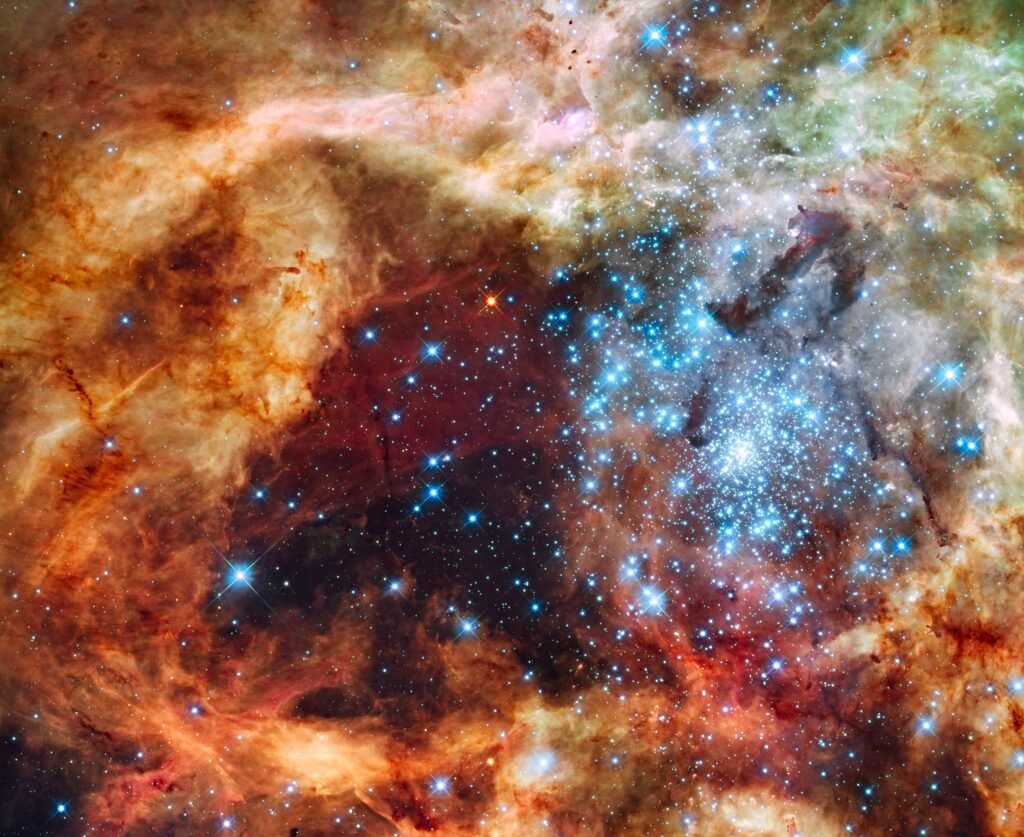In a universe that often feels dry and airless, astronomers have uncovered something astonishing: a vapor cloud in deep space holding roughly one hundred and forty trillion times the water found in all of Earth’s oceans. That figure bends the mind, and it also rewrites parts of our cosmic timeline, placing abundant water surprisingly early in the life of the universe. This is not an ocean you could sail, but a colossal veil of warm, diffuse molecules surrounding a ravenous quasar more than twelve billion light‑years away. When I first saw the estimate, I double‑checked it the way you recheck a restaurant bill that seems too low to be real. The number held, and with it came a simple truth – water is not a late luxury of mature galaxies; it’s been here since the cosmos was young.
The Hidden Clues

What if the largest pool of water we’ve ever found isn’t in any ocean at all, but in the thin breath of a galaxy’s heart? The clue hides in light, in the faint fingerprints that molecules leave as they jiggle and spin. Water vapor emits at specific millimeter and submillimeter wavelengths, and those spectral notes shift lower as the universe’s expansion stretches them across time.
By prying open that stretched light, astronomers saw water’s signature layered again and again, like a chorus carried across billions of years. Each line whispered about temperature, density, and motion, revealing not droplets but an immense, warm fog threaded through gas and dust. The story of the cloud didn’t arrive as a picture; it arrived as a symphony etched into radio waves.
From Ancient Tools to Modern Science

The path to this discovery runs from glass prisms to interferometers – centuries of ingenuity refining how we separate and read light. Early spectroscopy taught us that every element carries a barcode; modern arrays stitch together many antennas to sharpen the cosmic image and amplify faint signals. That combination lets scientists pick out water’s delicate patterns from the cosmic background noise.
It’s a bit like moving from a handheld compass to a GPS that sees through walls. Today’s instruments can detect lines that are both dim and redshifted, the twin hurdles of distance and cosmic expansion. With patience and calibration, those tools turn a murmur into a measurement.
A Quasar’s Thirst: Where the Water Hides

The vapor envelops a quasar – an active galactic nucleus lit by matter falling into a supermassive black hole. Around that engine, dust and molecular gas swirl in a chaotic halo, warmed by intense radiation but spread so thin you could travel light‑years before hitting a single molecule. In this regime, water exists as vapor, not liquid, rarified yet abundant when counted across the vast volume.
Picture the quasar’s surroundings as a sprawling city of gas with neighborhoods of different temperatures and densities. Water traces the warmer districts, places energized by radiation, shocks, and star formation. It’s not a lake; it’s weather – pervasive, dynamic, and constantly stirred.
Measuring the Immeasurable

How do you weigh a cloud you can’t touch and can barely see? Astronomers infer the amount of water by modeling the brightness of multiple emission lines, each one responding to temperature, density, and excitation in slightly different ways. By matching models to observations, they estimate a total content equivalent to roughly one hundred and forty trillion Earth‑oceans.
Distance complicates everything, because the light has been traveling for more than twelve billion years, and the universe has stretched it along the way. Even so, line ratios and the shape of the spectrum act like calipers, letting researchers triangulate conditions with surprising precision. In some cases, gravitational lensing may boost the signal, but the scale remains staggering even after conservative accounting.
Why It Matters

This discovery pushes water’s timeline back to when the universe was still young, less than a couple of billion years after the Big Bang. That’s crucial because water traces oxygen, which is forged in stars – seeing so much of it early means rapid star formation and enrichment were already underway. It also reframes a familiar narrative: water isn’t rare treasure sprinkled late; it can be a fundamental part of the galactic ecosystem from the start.
Compared with earlier techniques focused on nearby molecular clouds, this detection shows how far we can probe the chemistry of the distant universe. It links the microscopic – bonds between hydrogen and oxygen – to the grandest scales of black hole growth and galaxy evolution. Water becomes both a messenger and a metric for how galaxies ignite and mature.
Global Perspectives

Findings like this are the product of global collaboration, with telescopes in high deserts and mountaintops pooling their views of the faintest signals. Data pipelines now thread continents, as teams refine calibrations, compare models, and challenge each other’s assumptions. I’ve sat in those late‑night cross‑time‑zone calls; the excitement is palpable when a stubborn line finally clicks into place.
Science advances when ideas travel as freely as photons, and this result showcases that exchange. It also underscores the value of open archives, where reanalysis can squeeze new clues from old photons. In a very real sense, the world builds these discoveries together, piece by piece, baseline by baseline.
Surprising Chemistry in a Young Universe

Water in space forms through multiple routes, including reactions in warm gas and assembly on dust grains that later release molecules back into the cloud. Near a quasar, radiation can both destroy and create, breaking apart molecules in one region while driving fast chemistry in another. The net result is a complex balance that still yields enormous reservoirs of vapor over galactic scales.
That balance hints at rapid cycles of heating, cooling, and mixing, the same kinds of processes that seed stars and planets. It reminds us that chemistry doesn’t wait for calm; it flourishes in turbulence, too. The presence of water this early tells us the ingredients for habitability gather quickly, even if life’s recipe takes much longer to bake.
The Future Landscape

Next‑generation observatories will push deeper and sharper, mapping water and other molecules across cosmic time with unprecedented fidelity. Wider bandwidths will capture many lines at once, while more antennas extend baselines and resolve structure at scales that were recently out of reach. Pairing these maps with infrared and X‑ray views will connect cold gas, warm dust, and the black hole’s energetic heart into a unified portrait.
Expect more surprises: new reservoirs in unexpected galaxies, changing conditions across quasar neighborhoods, and perhaps early blueprints for planet‑forming chemistry. As instruments converge, models will be stress‑tested, revised, and refined. The goal isn’t just to tally molecules – it’s to understand how matter organizes itself into stars, disks, and, eventually, worlds.
Conclusion

If this discovery stirred your curiosity, you can turn that spark into fuel. Support open skies by backing dark‑sky policies in your community; dimmer nights make better astronomy and safer streets. Explore citizen‑science platforms that let you classify galaxies or hunt for transients from your laptop – every careful click helps.
Encourage science education at local schools, museums, and libraries, and if you can, subscribe to institutions that share data openly. The universe is vast, but discovery is intimate; it grows when more people look up and lean in. What new wonders do you want our telescopes to find next?

Suhail Ahmed is a passionate digital professional and nature enthusiast with over 8 years of experience in content strategy, SEO, web development, and digital operations. Alongside his freelance journey, Suhail actively contributes to nature and wildlife platforms like Discover Wildlife, where he channels his curiosity for the planet into engaging, educational storytelling.
With a strong background in managing digital ecosystems — from ecommerce stores and WordPress websites to social media and automation — Suhail merges technical precision with creative insight. His content reflects a rare balance: SEO-friendly yet deeply human, data-informed yet emotionally resonant.
Driven by a love for discovery and storytelling, Suhail believes in using digital platforms to amplify causes that matter — especially those protecting Earth’s biodiversity and inspiring sustainable living. Whether he’s managing online projects or crafting wildlife content, his goal remains the same: to inform, inspire, and leave a positive digital footprint.




